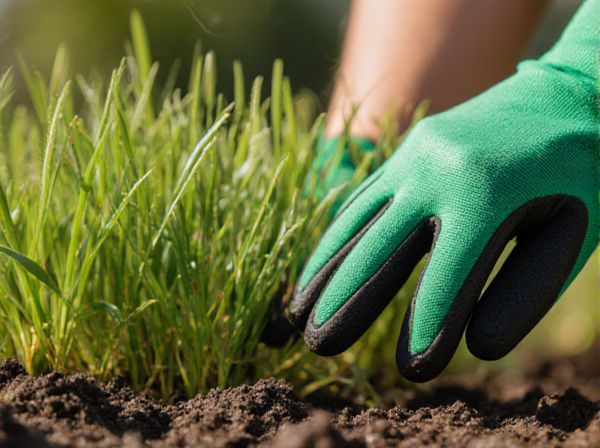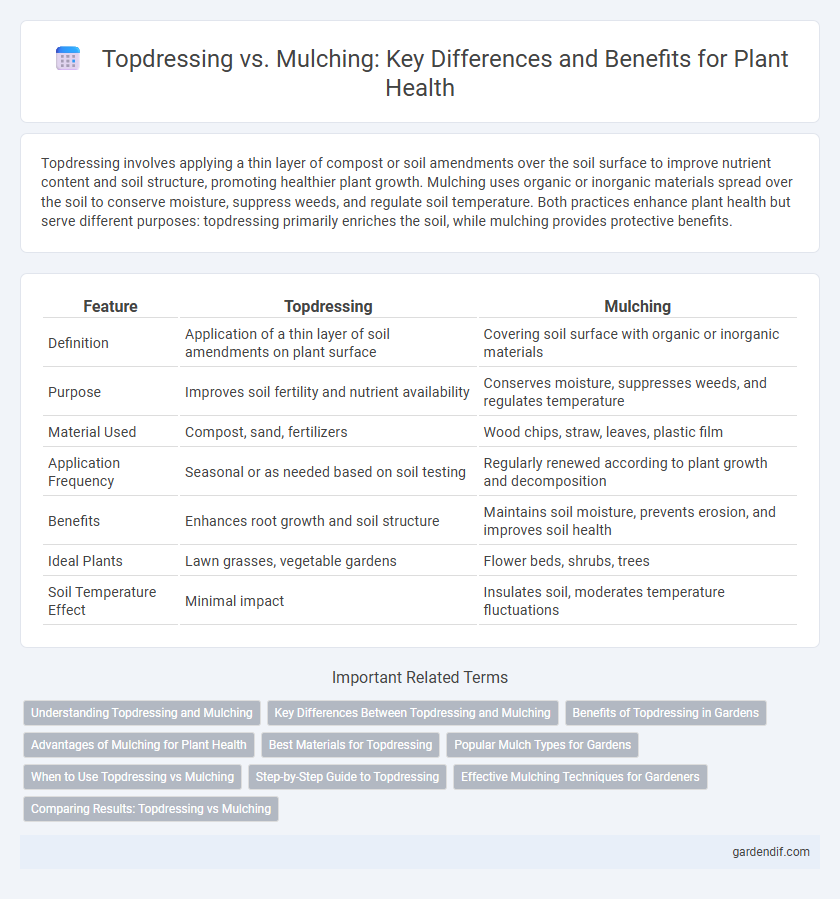
Topdressing vs Mulching Illustration
Topdressing involves applying a thin layer of compost or soil amendments over the soil surface to improve nutrient content and soil structure, promoting healthier plant growth. Mulching uses organic or inorganic materials spread over the soil to conserve moisture, suppress weeds, and regulate soil temperature. Both practices enhance plant health but serve different purposes: topdressing primarily enriches the soil, while mulching provides protective benefits.
Table of Comparison
| Feature | Topdressing | Mulching |
|---|---|---|
| Definition | Application of a thin layer of soil amendments on plant surface | Covering soil surface with organic or inorganic materials |
| Purpose | Improves soil fertility and nutrient availability | Conserves moisture, suppresses weeds, and regulates temperature |
| Material Used | Compost, sand, fertilizers | Wood chips, straw, leaves, plastic film |
| Application Frequency | Seasonal or as needed based on soil testing | Regularly renewed according to plant growth and decomposition |
| Benefits | Enhances root growth and soil structure | Maintains soil moisture, prevents erosion, and improves soil health |
| Ideal Plants | Lawn grasses, vegetable gardens | Flower beds, shrubs, trees |
| Soil Temperature Effect | Minimal impact | Insulates soil, moderates temperature fluctuations |
Understanding Topdressing and Mulching
Topdressing involves applying a thin layer of nutrient-rich soil or compost directly onto the plant bed to improve soil fertility and structure, promoting healthy root growth and enhanced nutrient absorption. Mulching refers to covering the soil surface around plants with organic or inorganic materials like bark, straw, or plastic to conserve moisture, suppress weeds, and regulate soil temperature. Both techniques play vital roles in sustainable gardening by optimizing soil health and plant growth through different mechanisms.
Key Differences Between Topdressing and Mulching
Topdressing involves applying a thin layer of soil or compost over grass to improve soil quality and promote healthy lawn growth, while mulching consists of placing organic or inorganic materials on the soil surface to conserve moisture and suppress weeds. Topdressing enhances nutrient content and soil aeration, whereas mulching primarily protects plant roots from temperature fluctuations and reduces soil erosion. Understanding these key differences helps optimize lawn care strategies for different plant health needs.
Benefits of Topdressing in Gardens
Topdressing improves soil fertility by gradually adding essential nutrients, enhancing plant growth and health. It promotes better soil structure and moisture retention, reducing water evaporation and supporting root development. Unlike mulching, topdressing integrates organic matter directly into the soil surface, fostering microbial activity for long-term garden vitality.
Advantages of Mulching for Plant Health
Mulching conserves soil moisture by reducing evaporation, creating a stable environment for root development and enhancing nutrient retention. It suppresses weed growth, minimizing competition for water and nutrients, which directly improves plant health and vigor. Organic mulches decompose over time, enriching the soil with essential nutrients and promoting beneficial microbial activity critical for sustainable plant growth.
Best Materials for Topdressing
The best materials for topdressing include finely screened compost, well-aged manure, and high-quality organic matter that enrich soil fertility and promote healthy plant growth. Applying a thin layer of these nutrient-rich materials improves soil structure, moisture retention, and microbial activity directly at the root zone. Unlike mulching, topdressing integrates nutrients into the soil surface, enhancing nutrient availability and supporting long-term plant health.
Popular Mulch Types for Gardens
Popular mulch types for gardens include organic options like shredded bark, straw, and composted leaves, which enhance soil fertility while regulating moisture and temperature. Inorganic mulches such as rubber mulch and gravel provide long-lasting weed control and improve garden aesthetics without decomposing. Choosing the right mulch type depends on plant species, soil condition, and desired maintenance level to optimize garden health and growth.
When to Use Topdressing vs Mulching
Topdressing is ideal during early spring or late fall to gradually enrich soil with nutrients and improve turfgrass health. Mulching is best applied in late spring or early summer to conserve moisture, regulate soil temperature, and suppress weed growth around plants. Use topdressing for lawns requiring slow nutrient release, while mulching suits garden beds needing moisture retention and protection from environmental stress.
Step-by-Step Guide to Topdressing
Topdressing involves applying a thin layer of nutrient-rich compost or soil amendment over the existing soil surface to enhance plant growth and soil health. Begin by removing debris and lightly aerating the soil, then evenly spread a 1/4 to 1/2 inch layer of quality organic compost or topsoil to provide essential nutrients and improve moisture retention. Water the area thoroughly to help nutrients penetrate the soil, promoting root development and overall plant vitality.
Effective Mulching Techniques for Gardeners
Effective mulching techniques for gardeners include applying a 2-4 inch layer of organic materials such as shredded bark, compost, or straw around plants to retain soil moisture and regulate temperature. Proper mulching reduces weed growth, improves soil fertility through gradual decomposition, and prevents erosion by protecting the soil surface. Selecting the right mulch type based on plant needs and local climate maximizes benefits and supports healthier plant development.
Comparing Results: Topdressing vs Mulching
Topdressing improves soil fertility by adding a thin layer of organic material, enhancing nutrient availability and promoting grass growth without significantly altering soil moisture levels. Mulching primarily conserves soil moisture, reduces weed growth, and stabilizes soil temperature by covering the surface with organic or inorganic materials. Comparing results, topdressing accelerates nutrient cycling and soil structure improvement, while mulching excels in moisture retention and erosion control, making each technique suitable for different horticultural goals.
Topdressing vs Mulching Infographic

 gardendif.com
gardendif.com